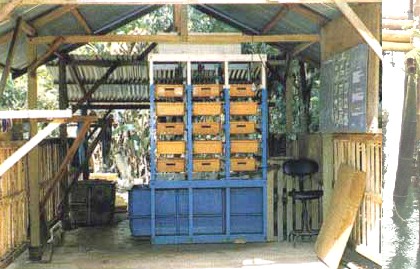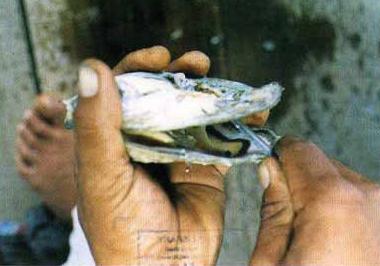|
Harvesting
Cultured oysters reach marketable size 9-12 months after stocking. Grow-out time
depends on initial stocking size. The usual market size is 9-12 cm. Harvesting raft-cultured
oysters is easily done by one person. Two persons are required to work the longline,
one to remove the oysters from trays and the other to control the boat.
The oysters’ are harvested when the condition is high. Good meat yield is
obtained during March-April and August-September. Harvesting is done manually. Oysters
kept under moist and cool conditions survive for several days. However, it is desirable
that they reach the consumer within three days of harvest. Studies indicate that
oysters packed in wet gunny bags are safely transported for 25-30 hrs without mortality
and in good condition.
After landing, the harvested oysters should be brushed and any fouling organisms
removed. Oysters should be depurated to ensure they are free of bacterial contamination.
Depuration
Oysters, like other filter-feeding bivalves, accumulate pathogenic organisms in
their body. The bacteria of concern are Vibrio, Salmonella and Escherichia
(Coliform type). Members of the Salmonella group cause typhoid fever, while
conforms and vibrios cause gastroenteritis. By depuration the bacterial load is
brought down to permissible levels; also faeces, sand particles and silt are removed
from the alimentary canal of the oysters.
The oysters are placed for 24 hrs in cleaning tanks under a now of filtered seawater.
About 10-20% of the seawater is continuously replaced. At the end of 12 hrs the
water in the tank is drained and oysters are cleaned by a strong jet of water to
remove the accumulated faeces. The tanks are again filled with filtered seawater
and the flow is maintained for another 12 hrs. Then the tanks are drained and flushed
with a jet of filtered sea water. The oysters are held for about an hour in 3 ppm
chlorinated seawater, and then washed once again in filtered seawater before marketing.

Small scale depuration unit
Shucking
The removal of the meat from the oyster is called shucking. A stainless steel knife
is used for the purpose. To render shucking easy, oysters arc subjected to a wide
range of treatments such as exposure to weak hydrochloric acid, heat, cold, vacuum,
microwaves and lasers. Freezing the oysters, or immersing them in hot water are
the two methods commonly followed.

Shucking
Top
|